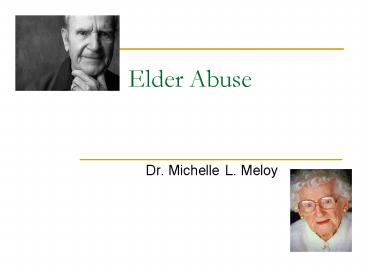Elder Abuse - PowerPoint PPT Presentation
1 / 14
Title: Elder Abuse
1
Elder Abuse
- Dr. Michelle L. Meloy
2
Domestic elder abuse
- By the year 2030, the population over the age of
65 will triple to nearly 70 million - Violence or neglect that occurs in domestic
settings is a serious complex social problem - Victims are often invisible leading to
tremendous under-reporting - National Center on Elder abuse reports a 150
increase in reporting since 1986 - Prevalence rates are estimated at about 500,000
to 2 million victims (if self-injury included) - Every case reported 5 unreported
3
Categories of elder abuse
- Physical abuse
- Sexual abuse
- Emotional abuse
- Financial exploitation
- Neglect passive and active
- Abandonment
- Self-neglect
4
Indicators of abuse Physical
- Overt signs of physical trauma
- Repeated "unexplained" injuries in inconsistent
explanations - A physical examination reveals that the older
person has injuries which the caregiver has
failed to disclose - A history of doctor or emergency room "shopping"
- Repeated time lags between the time of any
"injury or fall" and medical treatment
5
Indicators of abuse Sexual Abuse
- Trauma to the genital area (e.g. bruises)
- Venereal disease
- Infections/unusual discharge
- Indicators common to psychological abuse may be
concomitant with sexual abuse
6
Indicators of abuse Emotional
- Psychological Signs
- Ambivalence, deference, passivity, shame
- Anxiety (mild to severe)
- Depression, hopelessness, helplessness, thoughts
of suicide - Confusion, disorientation
- Behavioral Signs
- Trembling, clinging, cowering, lack of eye
contact - Evasiveness
- Agitation
- Hypervigilance
7
Indicators of abuse Financial
- Unusual banking activity
- Elder cannot understand financial documents they
are being asked to sign - Living situation does not match financial
situation - The caregiver only expresses concern regarding
the financial status - Personal belongings such as jewelry, art, furs
are missing - Signatures on checks and other documents do not
match - Care providers isolate the elder
8
Indicators of abuse Passive and active neglect
- Evidence that personal care is lacking or
neglected - Signs of malnourishment (e.g. sunken eyes, loss
of weight) - Chronic health problems both physical and/or
psychiatric - Dehydration (extreme thirst)
- Pressure sores (bed sores)
9
Most likely forms of abuse in domestic settings
- According to state adult protective services
- Neglect 55 of reports
- Physical abuse 15
- Financial exploitation 12.3
- Emotional abuse 8
- Sexual abuse less than 1
- When elders (over age 60) are murdered, their
off-spring are the killers 42 of the time
spouses 24 of the time
10
Risk factors victim characteristics
- Elders may be more dependent on their abuser than
victims of IPV - Average age is 78
- elders over the age of 80 are 2 to 3 times more
likely to be abused or neglected - Most are female (67)
- females are overrepresented even when controlling
for their larger population proportion - Racial breakdowns
- White victims (66)
- Black victims (18.7)
- Hispanic victims (10.4)
11
Victim-offender relationship
- In 90 of the cases where a known perpetrator,
the abuser is a family member - Grown child of the victim (53) or grandchild
(19) - Spouse (16) Domestic violence grown old many
of the spouses who abuse their elder partners did
so in their youth also - Other family members or caregivers
12
Risk factors
- Psychological strains
- Social isolation
- Economic stress
- Emotional and physical condition of the victim
and the caregiver - Elders who are emotionally or financially
dependent on their caregiver, particularly in the
case of grown children, have a greater risks
13
Causes of elder abuse
- Caregiver stress theory suggests that well
intentioned caregivers are so overwhelmed that
they lose it and strike out against elder.
Empirical evidence is weak. - Personal characteristics of the elder these
theories suggest that dementia, disruptive
behaviors, problematic personality types and
significant needs from caregiver increase odds of
abuse. Evidence here is mixed.
14
Causes of elder abuse
- Cycle of violence theory suggests that elder
abuse is learned as a conflict resolution skill
that is passed down through the generations.
What goes around comes around in cases where
adult caregiver is abusing parent after being
abused in their childhood - Evidence is strong on other domestic violence
populations (intimate partner violence and child
abuse but has never been tested as the cause of
elder abuse)































![DOWNLOAD [PDF] Elder Abuse Prevention: Emerging Trends and Promising S PowerPoint PPT Presentation](https://s3.amazonaws.com/images.powershow.com/10127001.th0.jpg?_=20240909101)